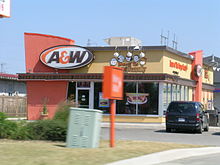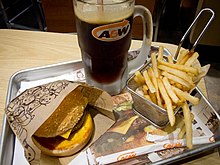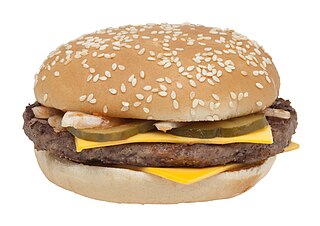
A hamburger, also called a burger, is a food consisting of fillings—usually a patty of ground meat, typically beef—placed inside a sliced bun or bread roll. The patties are often served with cheese, lettuce, tomato, onion, pickles, bacon or chilis with condiments such as ketchup, mustard, mayonnaise, relish or a "special sauce", often a variation of Thousand Island dressing and are frequently placed on sesame seed buns. A hamburger patty topped with cheese is called a cheeseburger.
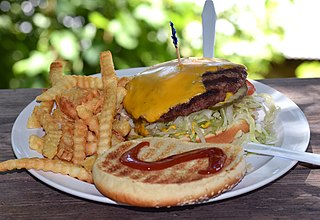
A cheeseburger is a hamburger with a slice of melted cheese on top of the meat patty, added near the end of the cooking time. Cheeseburgers can include variations in structure, ingredients and composition. As with other hamburgers, a cheeseburger may include various condiments and other toppings such as lettuce, tomato, onion, pickles, bacon, avocado, mushrooms, mayonnaise, ketchup, and mustard.

The Big Mac is a hamburger sold by the international fast food restaurant chain McDonald's. It was introduced in the Greater Pittsburgh area in 1967 and across the United States in 1968. It is one of the company's flagship products and signature dishes. The Big Mac contains two beef patties, cheese, shredded lettuce, pickles, minced onions, and a Thousand Island-type dressing advertised as "special sauce", on a three-slice sesame-seed bun.
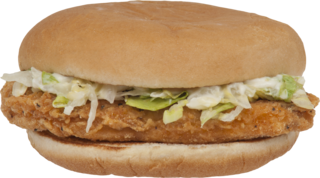
The McChicken is a chicken sandwich sold by the international fast food restaurant McDonald's. In some countries, such as Australia, Fiji, India, New Zealand, and the UK, it is considered to be a chicken burger, especially given it is not a sandwich as that word is understood in some of those non-American varieties of English. It consists of a toasted wheat bun, a breaded patty, shredded lettuce and mayonnaise.

The Quarter Pounder is a hamburger sold by international fast food chain McDonald's, so named for containing a patty with a precooked weight of four ounces (113.4 g), or one quarter of a pound. It was introduced in 1971. In 2013, the Quarter Pounder was expanded to represent a whole line of hamburgers that replaced the company's discontinued Angus hamburger. In 2015, McDonald's increased the precooked weight to 4.25 oz (120 g).

The Big King sandwich is one of the major hamburger products sold by the international fast-food restaurant chain Burger King, and was part of its menu for more than twenty years. As of March 2019, it is sold in the United States under its 1997 Big King XL formulation. During its testing phase in 1996–1997, it was originally called the Double Supreme and was configured similarly to the McDonald's Big Mac—including a three-piece roll. It was later reformulated as a more standard double burger during the latter part of product testing in 1997. It was given its current name when the product was formally introduced in September 1997, but maintained the more conventional double cheeseburger format.

Different areas of the world have local variations on the hot dog, in the type of meat used, the condiments added, and its means of preparation.

The BK Stacker sandwiches are a family of cheeseburgers sold by the international fast-food restaurant chain Burger King.

When In-N-Out Burger first opened in 1948, the company only provided a basic menu of burgers, fries and beverages. The foods it prepared were made on-site from fresh ingredients, including its french fries which were sliced and cooked to order. Unlike other major competitors in the hamburger fast food restaurant business, as the chain has expanded over the years, it has not added products such as chicken or salads to its menu since 1976 and has never changed its preparation methods.

The McDonald's Deluxe line was a series of sandwiches introduced in the early to mid 1990s and marketed by McDonald's with the intent of capturing the adult fast food consumer market, presented as a more sophisticated burger for adult tastes. The sandwiches sold poorly and the entire line was discontinued on August 18, 2000. The Deluxe series was a marketing disaster and is now considered to be one of the most expensive flops in McDonald's history.
McDonald's Corporation is the world's largest chain of fast food restaurants, serving around 68 million customers daily in 119 countries. McDonald's traces its origins to a 1940 restaurant in San Bernardino, California. After expanding within the United States, McDonald's became an international corporation in 1967, when it opened a location in Richmond, British Columbia, Canada. By the end of the 1970s, McDonald's restaurants existed in five of the Earth's seven continents; an African location came in 1992 in Casablanca, Morocco.

A steak sandwich is a sandwich prepared with steak that has been broiled, fried, grilled, barbecued or seared using steel grates or gridirons, then served on bread or a roll. Steak sandwiches are sometimes served with toppings of cheese, onions, mushrooms, peppers, tomatoes, and in some instances fried eggs, coleslaw, and french fries.

Wendy's is an American international fast food restaurant chain founded by Dave Thomas on November 15, 1969, in Columbus, Ohio. Its headquarters moved to Dublin, Ohio, on January 29, 2006. As of December 31, 2018, Wendy's was the world's third-largest hamburger fast-food chain with 6,711 locations, following Burger King and McDonald's. On September 29, 2008, the company merged with Triarc Companies Inc., the publicly traded parent company of Arby's; Wendy's headquarters remained in Dublin. Triarc then became known as Wendy's/Arby's Group, and later as the Wendy's Company following the sale of Arby's to Roark Capital Group.
A hamburger is a specific type of burger. It is a sandwich that consists of a cooked ground beef meat patty, placed between halves of a sliced bun. Hamburgers are often served with various condiments, such as dill relish (condiment), mayonnaise, and other options including lettuce, tomato, onion, pickles, and cheese.

Burger King sliders, comprising several varieties of mini-sandwiches, are a series of sandwiches that have been sold by international fast-food restaurant chain Burger King since the 1980s. Burger Bundles was the first iteration, a set of three small hamburgers or cheeseburgers. These sandwiches were eventually replaced with a reformulated product called Burger Buddies that was sold in pairs. After a change in management in 2004, Burger Buddies were re-released as BK Burger Shots. The company has also sold several chicken and breakfast sandwich versions of these products.

The Big N’ Tasty is a hamburger sold by the international fast food chain McDonald's. It is designed to compete with the Whopper sandwich. A similar variation called the Big Tasty, without the center "N'", which was first released in Saudi Arabia, is sold outside the United States in parts of Europe, South America, South Africa, The Middle East, and Taiwan.

McDonald's Restaurants Limited is the New Zealand subsidiary of the international fast food restaurant chain McDonald's. Its first location opened in 1976. In 2017 McDonald's New Zealand had 167 restaurants operating nationwide, serving an estimated one million people each week. The company earned revenues of over $250 million in the 2018 financial year.


